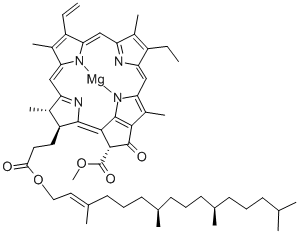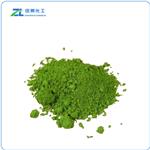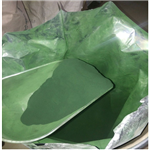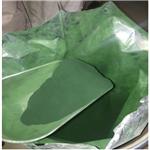Description
Chlorophyll is the green pigment in plants that allows them to create energy from light – to photosynthesize. Chlorophyll A and B are two major types of chlorophyll found in plants and green algae. Both are involved in the process photosynthesis. Both chlorophyll A and B are found in chloroplasts, associated with integral membrane proteins in the thylakoid membrane. The main difference between chlorophyll A and B is their role in photosynthesis? chlorophyll A is the principal pigment involved in the photosynthesis whereas chlorophyll B is the accessory pigment, collecting the energy in order to pass into chlorophyll A. In chlorophyll A, the most effectively absorbing wavelengths of the spectrum are 429 nm and 659 nm, which are responsible for violet-blue and orange-red colors, respectively.
Chemical Properties
Waxy solid. Olive to dark green, depending on the amount of magnesium incorporated. Slightly smelly. The melting point of chlorophyll a is 150~153°C, and the melting point of chlorophyll b is 183~185°C. It coexists with the yellow carotene and lutein in the chloroplasts of plant leaves. Sensitive to light and heat, it can be saponified and hydrolyzed into bright green chlorophyllin (salt), phytol and methanol in dilute lye solution, and dark green to green-brown pheophytin in acid solution. Insoluble in water. Soluble in ethanol, ether, acetone and other fatty solvents.
Occurrence
Chlorophyll A is found in all plants, algae and cyanobacteria.
Uses
Chlorophyll A is a photosynthetic pigment that is essential for photosynthesis of eukaryotes and cyanobacteria, acting as a primary donor in the electron transport chain. Dyes and metabolites.
Definition
Chlorophyll A is a form of chlorophyll that absorbs light in the violet to red spectrum (approximately 400-700 nm wavelength range) and reflects green light (500-570 nm wavelength), which imparts the characteristic green color to land plants. It is occurs in all photosynthetic organisms and is the major species in all of those that evolve oxygen.
General Description
Chlorophyll a is present as a key pigment in organisms with oxygenic photosynthesis. It functions as an antenna pigment in both reaction centers I and II.
Biochem/physiol Actions
Chlorophyll a is an essential pigment in oxygenic photosynthesis. In photosystems, it is present as an antenna pigment as well as in reaction center I and II. Chlorophyll a is a blue-green pigment which absorbs light in 400-450nm and 640-660nm range. In photosynthesis, the energy absorbed by chlorophyll transforms carbon dioxide and water into carbohydrates and oxygen. When chlorophyll absorbs light energy, an electron in chlorophyll is excited from a lower energy state to a higher energy state. In this higher energy state, the electron is more readily transferred to another molecule. This starts a chain of electron-transfer steps, which ends with an electron transferred to carbon dioxide.
Purification Methods
It forms green crystals from Me2CO, Et2O/H2O, Et2O/hexane/H2O or Et2O/pentane /H2O. It is sparingly soluble in MeOH and insoluble in pet ether. In alkaline solution it gives a blue-green colour with deep red fluorescence. A very crude chlorophyll mixture has been purified by chromatography on low melting polyethylene (MI 0.044; “Dow” melting index MI <2) and developed with 70% aqueous Me2CO. The order of effluent from the bottom of the column is: xanthophylls, chlorophyll b , chlorophyll a, phaeophytins and carotenes. A mixture of chlorophylls a and b is best separated by chromatography on sugar, and the order is chlorophyll b elutes first followed by chlorophyll a. To an Me2CO/H2O solution of chlorophylls 200mL of iso-octane are added, and the mixture shaken in a separating funnel and the H2O is carefully removed. The iso-octane layer is dried (Na2SO4) and applied onto a glass column (5cm diameter) dry packed with 1000mL of powdered sucrose which has been washed with 250mL of iso-octane. Elution with 0.5% of isopropanol in iso-octane gives chlorophyll a. Keeping the eluate overnight at 0o yields micro crystals which are collected by filtration or centrifugation (Yield 40mg). UVEtOH has max 660, 613, 577, 531, 498, 429 and 409 nm. Note that anhydrous chlorophylls can be easily enolized, epimerized or allomerized in dry polar organic solvents. [Anderson & Calvin Nature 194 285 1962, Stoll & Weidemann Helv Chim Acta 16 739 757 1933, NMR: Katz et al. J Am Chem Soc 90 6841 1968, 85 3809 1963 for a and b; ORD: Inhoffen et al. Justus Liebigs Ann Chem 704 208 1967, Willst.tter & Isler Justus Liebigs Ann Chem 390 269, 233 1912, Beilstein 26 III/IV 3243.]




